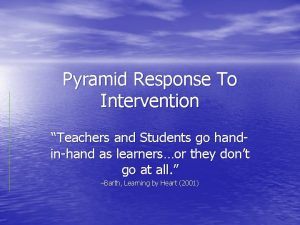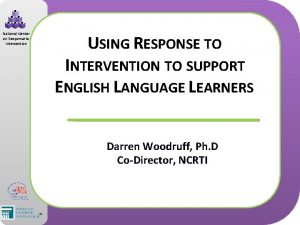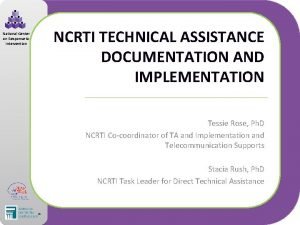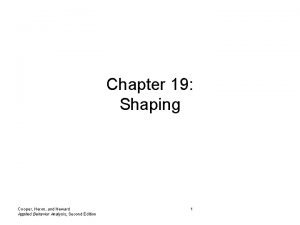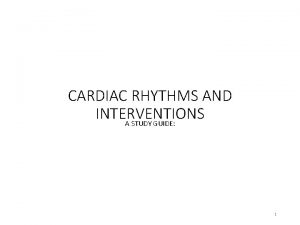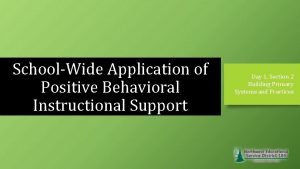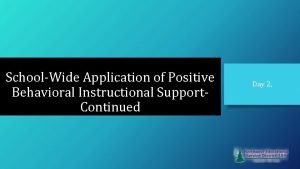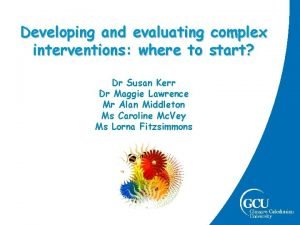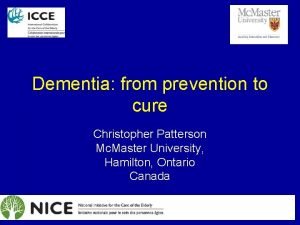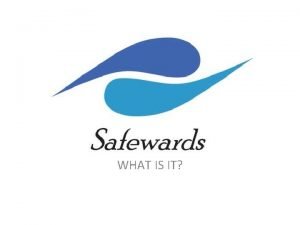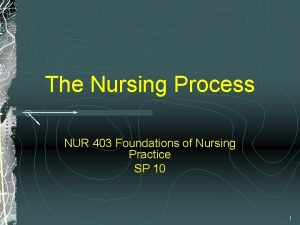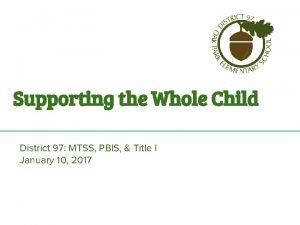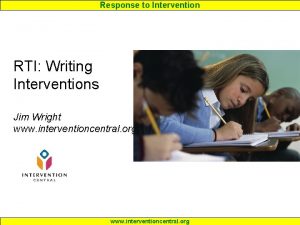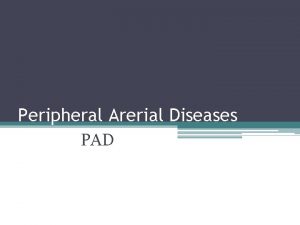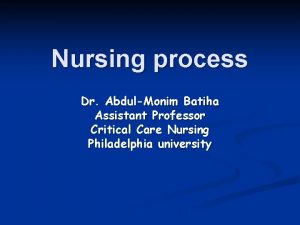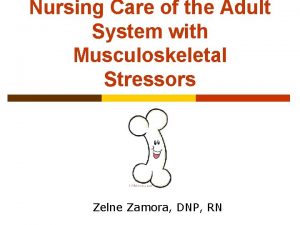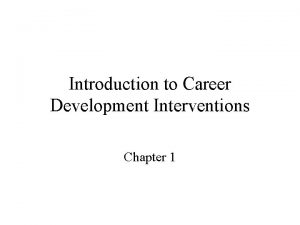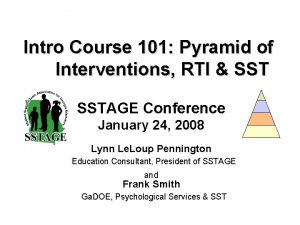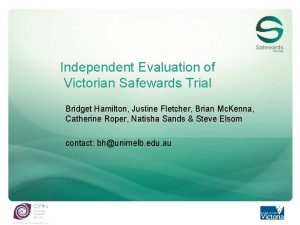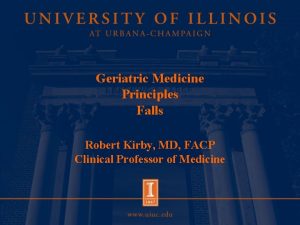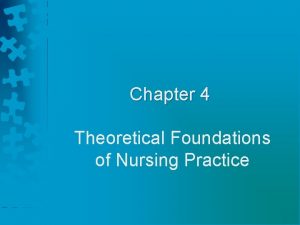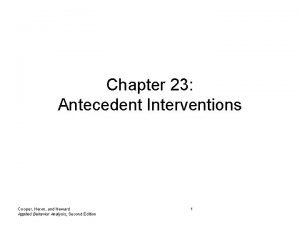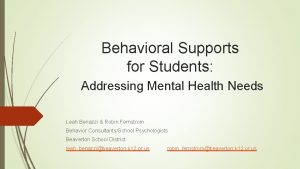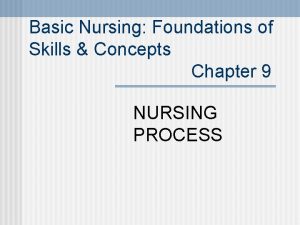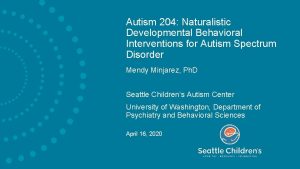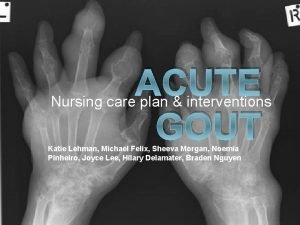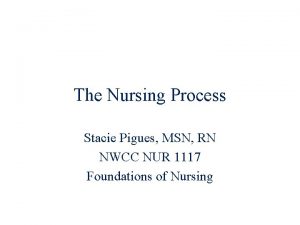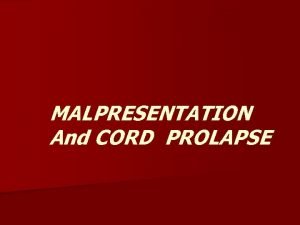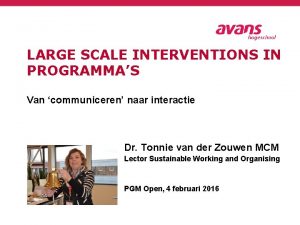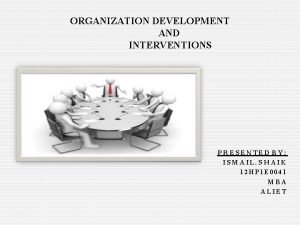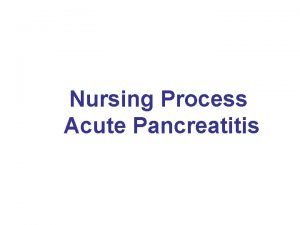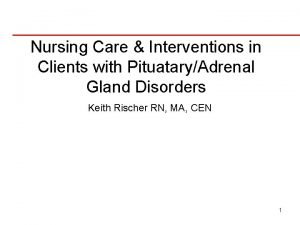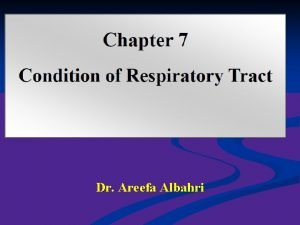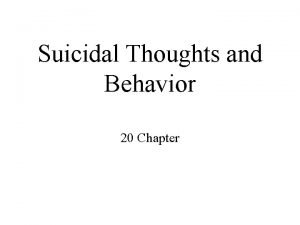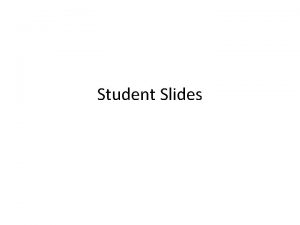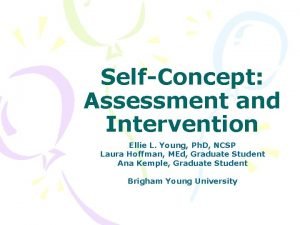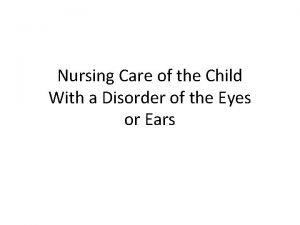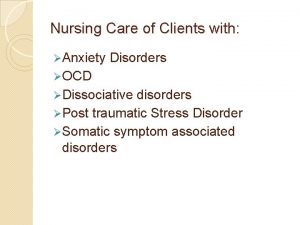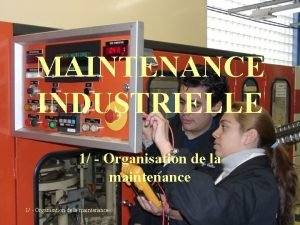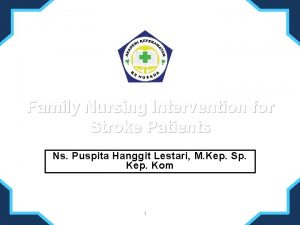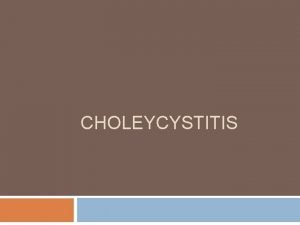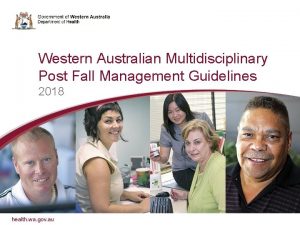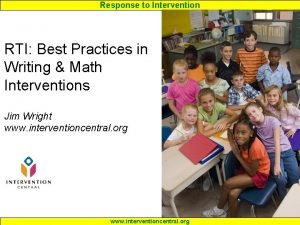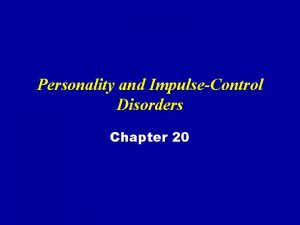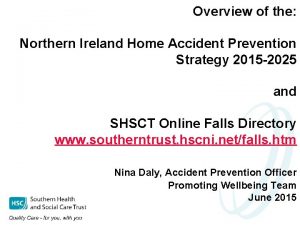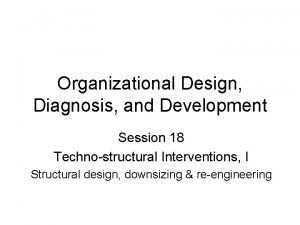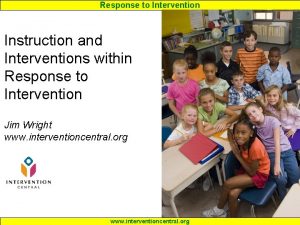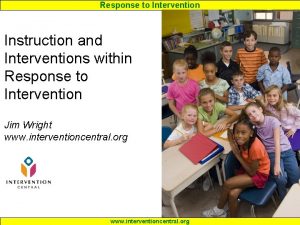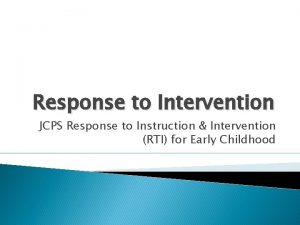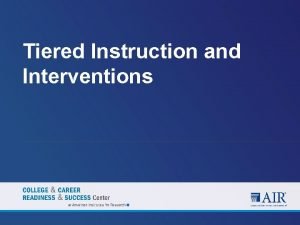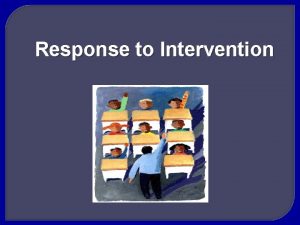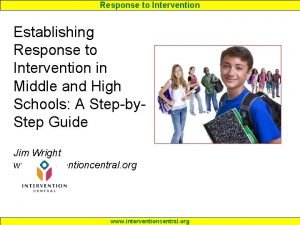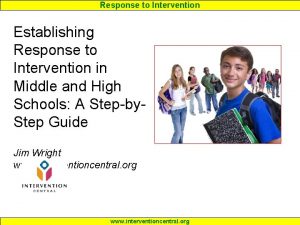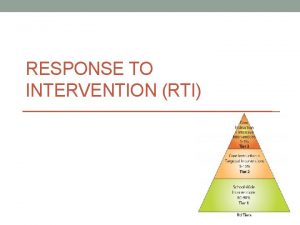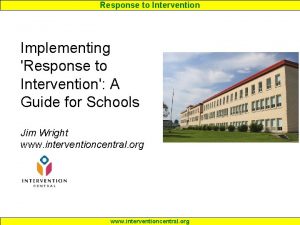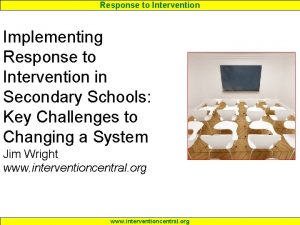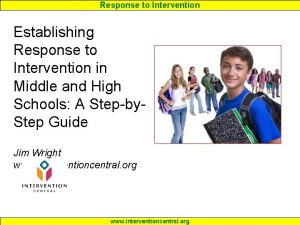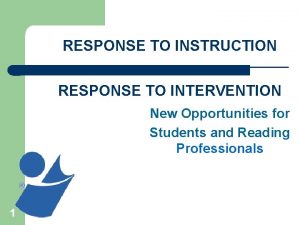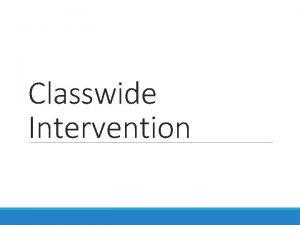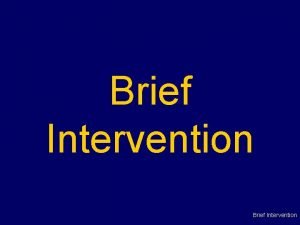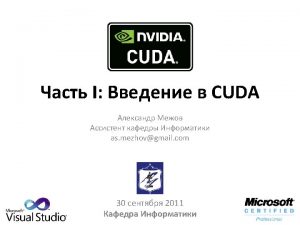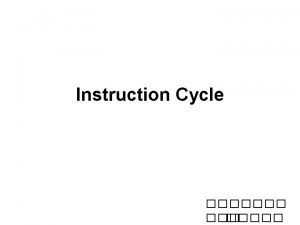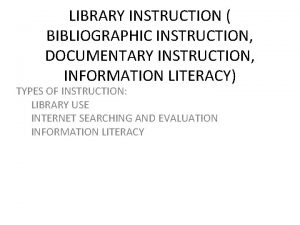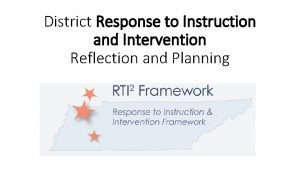Response to Intervention Instruction and Interventions within Response














































































- Slides: 78

Response to Intervention Instruction and Interventions within Response to Intervention Jim Wright www. interventioncentral. org

Response to Intervention Instruction & Interventions Within RTI: Workshop Agenda RTI & Academic Interventions: Overview Reading Interventions Math Interventions Writing Interventions Strategies to Encourage Teachers to Implement Classroom Interventions Systems Change: Developing Intervention Capacity Throughout a School Web Resources to Support Academic Interventions www. interventioncentral. org

Response to Intervention Research & Development: A Work in Progress www. interventioncentral. org

Response to Intervention Tier 1: What Are the Recommended Elements of ‘Core Curriculum’? : More Research Needed “In essence, we now have a good beginning on the evaluation of Tier 2 and 3 interventions, but no idea about what it will take to get the core curriculum to work at Tier 1. A complicating issue with this potential line of research is that many schools use multiple materials as their core program. ” p. 640 Source: Kovaleski, J. F. (2007). Response to intervention: Considerations for research and systems change. School Psychology Review, 36, 638 -646. www. interventioncentral. org 4

Response to Intervention Limitations of Intervention Research… “…the list of evidence-based interventions is quite small relative to the need [of RTI]…. Thus, limited dissemination of interventions is likely to be a practical problem as individuals move forward in the application of RTI models in applied settings. ” p. 33 Source: Kratochwill, T. R. , Clements, M. A. , & Kalymon, K. M. (2007). Response to intervention: Conceptual and methodological issues in implementation. In Jimerson, S. R. , Burns, M. K. , & Van. Der. Heyden, A. M. (Eds. ), Handbook of response to intervention: The science and practice of assessment and intervention. New York: Springer. www. interventioncentral. org 5

Response to Intervention Schools Need to Review Tier 1 (Classroom) Interventions to Ensure That They Are Supported By Research There is a lack of agreement about what is meant by ‘scientifically validated’ classroom (Tier I) interventions. Districts should establish a ‘vetting’ process—criteria for judging whether a particular instructional or intervention approach should be considered empirically based. Source: Fuchs, D. , & Deshler, D. D. (2007). What we need to know about responsiveness to intervention (and shouldn’t be afraid to ask). . Learning Disabilities Research & Practice, 22(2), 129– 136. www. interventioncentral. org 6

Response to Intervention What Are Appropriate Content-Area Tier 1 Universal Interventions for Secondary Schools? “High schools need to determine what constitutes high-quality universal instruction across content areas. In addition, high school teachers need professional development in, for example, differentiated instructional techniques that will help ensure student access to instruction interventions that are effectively implemented. ” Source: Duffy, H. (August 2007). Meeting the needs of significantly struggling learners in high school. Washington, DC: National High School Center. Retrieved from http: //www. betterhighschools. org/pubs/ p. 9 www. interventioncentral. org 7

Response to Intervention RTI & Intervention: Key Concepts www. interventioncentral. org

Response to Intervention Essential Elements of Any Academic or Behavioral Intervention (‘Treatment’) Strategy: • Method of delivery (‘Who or what delivers the treatment? ’) Examples include teachers, paraprofessionals, parents, volunteers, computers. • Treatment component (‘What makes the intervention effective? ’) Examples include activation of prior knowledge to help the student to make meaningful connections between ‘known’ and new material; guide practice (e. g. , Paired Reading) to increase reading fluency; www. interventioncentral. org periodic review of material to aid 9

Response to Intervention Core Instruction, Interventions, Accommodations & Modifications: Sorting Them Out • Core Instruction. Those instructional strategies that are used routinely with all students in a general-education setting are considered ‘core instruction’. Highquality instruction is essential and forms the foundation of RTI academic support. NOTE: While it is important to verify that good core instructional practices are in place for a struggling student, those routine practices do not ‘count’ as individual student interventions. www. interventioncentral. org 10

Response to Intervention Core Instruction, Interventions, Accommodations & Modifications: Sorting Them Out • Intervention. An academic intervention is a strategy used to teach a new skill, build fluency in a skill, or encourage a child to apply an existing skill to new situations or settings. An intervention can be thought of as “a set of actions that, when taken, have demonstrated ability to change a fixed educational trajectory” (Methe & Riley-Tillman, 2008; p. 37). www. interventioncentral. org 11

Response to Intervention Core Instruction, Interventions, Accommodations & Modifications: Sorting Them Out • Accommodation. An accommodation is intended to help the student to fully access and participate in the general-education curriculum without changing the instructional content and without reducing the student’s rate of learning (Skinner, Pappas & Davis, 2005). An accommodation is intended to remove barriers to learning while still expecting that students will master the same instructional content as their typical peers. – Accommodation example 1: Students are allowed to supplement silent reading of a novel by listening to the book on tape. – Accommodation example 2: For unmotivated students, the instructor breaks larger assignments into smaller ‘chunks’ and providing students with www. interventioncentral. org 12

Response to Intervention “ “Teaching is giving; it isn’t taking away. ” ” (Howell, Hosp & Kurns, 2008; p. 356). Source: Howell, K. W. , Hosp, J. L. , & Kurns, S. (2008). Best practices in curriculum-based evaluation. In A. Thomas & J. Grimes (Eds. ), Best practices in school psychology V (pp. 349 -362). Bethesda, MD: National Association of School Psychologists. . www. interventioncentral. org 13

Response to Intervention Core Instruction, Interventions, Accommodations & Modifications: Sorting Them Out • Modification. A modification changes the expectations of what a student is expected to know or do—typically by lowering the academic standards against which the student is to be evaluated. Examples of modifications: – Giving a student five math computation problems for practice instead of the 20 problems assigned to the rest of the class – Letting the student consult course notes during a test when peers are not permitted to do so www. interventioncentral. org 14

Response to Intervention ‘Intervention Footprint’: 7 -Step Lifecycle of an Intervention Plan… 1. Information about the student’s academic or behavioral concerns is collected. 2. The intervention plan is developed to match student presenting concerns. 3. Preparations are made to implement the plan. 4. The plan begins. 5. The integrity of the plan’s implementation is measured. 6. Formative data is collected to evaluate the plan’s effectiveness. www. interventioncentral. org 15

Response to Intervention Team Activity: What Are Challenging Issues in Your School Around the Topic of Academic Interventions? … At your tables: • Discuss the task of promoting the use of ‘evidence-based’ academic interventions in your school. • What are enabling factors that should help you to promote the routine use of such interventions. • What are challenges or areas needing improvement to allow you to promote use of those interventions? www. interventioncentral. org 16

Response to Intervention Big Ideas: The Four Stages of Learning Can Be Summed Up in the ‘Instructional Hierarchy’ pp. 2 -3 (Haring et al. , 1978) Student learning can be thought of as a multi-stage process. The universal stages of learning include: • Acquisition: The student is just acquiring the skill. • Fluency: The student can perform the skill but must make that skill ‘automatic’. • Generalization: The student must perform the skill across situations or settings. • Adaptation: The student confronts novel task demands that require that the student adapt a current skill to meet new requirements. Source: Haring, N. G. , Lovitt, T. C. , Eaton, M. D. , & Hansen, C. L. (1978). The fourth R: Research in the classroom. Columbus, OH: Charles E. Merrill Publishing Co. www. interventioncentral. org 17

Response to Intervention Increasing the Intensity of an Intervention: Key Dimensions Interventions can move up the RTI Tiers through being intensified across several dimensions, including: • • • Type of intervention strategy or materials used Student-teacher ratio Length of intervention sessions Frequency of intervention sessions Duration of the intervention period (e. g. , extending an intervention from 5 weeks to 10 weeks) • Motivation strategies Source: Burns, M. K. , & Gibbons, K. A. (2008). Implementing response-to-intervention in elementary and secondary schools. Routledge: New York. Kratochwill, T. R. , Clements, M. A. , & Kalymon, K. M. (2007). Response to intervention: Conceptual and methodological issues in implementation. In Jimerson, S. R. , Burns, M. K. , & Van. Der. Heyden, A. M. (Eds. ), Handbook of response to intervention: The science and practice of assessment and intervention. New York: Springer. www. interventioncentral. org 18

Response to Intervention RTI Interventions: What If There is No Commercial Intervention Package or Program Available? “Although commercially prepared programs and the subsequent manuals and materials are inviting, they are not necessary. … A recent review of research suggests that interventions are research based and likely to be successful, if they are correctly targeted and provide explicit instruction in the skill, an appropriate level of challenge, sufficient opportunities to respond to and practice the skill, and immediate feedback on performance…Thus, these [elements] could be used as with toresponse-to-intervention judge potential tierand 2 Source: Burns, M. K. , &criteria Gibbons, K. A. (2008). which Implementing in elementary secondary schools. Routledge: New York. interventions. ” p. 88 www. interventioncentral. org 19

Response to Intervention Research-Based Elements of Effective Academic Interventions • ‘Correctly targeted’: The intervention is appropriately matched to the student’s academic or behavioral needs. • ‘Explicit instruction’: Student skills have been broken down “into manageable and deliberately sequenced steps and providing overt strategies for students to learn and practice new skills” p. 1153 • ‘Appropriate level of challenge’: The student experiences adequate success with the instructional task. • ‘High opportunity to respond’: The student actively responds at a rate frequent enough to promote Source: effective Burns, M. K. , Van. Der. Heyden, learning. A. M. , & Boice, C. H. (2008). Best practices in intensive academic interventions. In A. Thomas & J. Grimes (Eds. ), Best practices in school psychology V (pp. 1151 -1162). Bethesda, MD: National Association School Psychologists. • ‘Feedback’: Theofstudent receives prompt www. interventioncentral. org 20

Response to Interventions: Potential ‘Fatal Flaws’ Any intervention must include 4 essential elements. The absence of any one of the elements would be considered a ‘fatal flaw’ (Witt, Van. Der. Heyden & Gilbertson, 2004) that blocks the school from drawing meaningful conclusions from the student’s response to the intervention: 1. Clearly defined problem. The student’s target concern is stated in specific, observable, measureable terms. This ‘problem identification statement’ is the most important step of the problem-solving model (Bergan, 1995), as a clearly defined problem allows the teacher or RTI Team to select a wellmatched intervention to address it. 2. Baseline data. The teacher or RTI Team measures the student’s academic skills in the target concern (e. g. , reading fluency, math computation) prior to beginning the intervention. Baseline data becomes the point of comparison throughout the intervention to help the school to determine whether that intervention is effective. 3. Performance goal. The teacher or RTI Team sets a specific, data-based goal for student improvement during the intervention and a checkpoint date by which the goal should be attained. 4. Progress-monitoring plan. The teacher or RTI Team collects student data Source: Witt, J. to C. , determine Van. Der. Heyden, A. M. , & Gilbertson, D. (2004). Troubleshooting behavioral regularly whether the student is on-track to reach the interventions. A systematic performance goal. process for finding and eliminating problems. School Psychology Review, 33, 363 -383. www. interventioncentral. org 21

Response to Intervention RTI: Writing Interventions Jim Wright www. interventioncentral. org

Response to Intervention www. interventioncentral. org 23

Response to Intervention Team: Writing Concerns in Your School or District • In your group, discuss concerns that you have about struggling student writers in your school or district. • Be prepared to share your discussion with the larger group. www. interventioncentral. org 24

Response to Intervention Defining Student Writing Problems www. interventioncentral. org

Response to Intervention Writing Sample Determine the 1 or 2 most important features in this writing that should be targeted for intervention. [If lost on an island] I woud drink water from the ocean and I woud eat the fruit off of the trees. Then I woud bilit a house out of trees, and I woud gather firewood to stay warm. I woud try and fix my boat in my spare time. www. interventioncentral. org 26

Response to Intervention Determine the 1 or 2 most important features in this writing that should be targeted for intervention. Existing is being unique. Existence, reality, essence, cause, or truth is uniqueness. The geometric point in the center of the sphere is nature’s symbol of the immeasurable uniqueness within its measurable effect. A center is always unique; otherwise it would not be a center. Because uniqueness is reality, or that which makes a thing what it is, everything that is real is based on a centralization. www. interventioncentral. org 27

Response to Intervention "If all the grammarians in the world were placed end to end, it would be a good thing. " – Oscar Wilde www. interventioncentral. org 28

Response to Intervention Graham, S. , & Perin, D. (2007). Writing next: Effective strategies to improve writing of adolescents in middle and high schools – A report to Carnegie Corporation of New York. Washington, DC Alliance for Excellent Education. Retrieved from http: //www. all 4 ed. org/files/ Writing. Next. pdf www. interventioncentral. org 29

Response to Intervention The Effect of Grammar Instruction as an Independent Activity “Grammar instruction in the studies reviewed [for the Writing Next report] involved the explicit and systematic teaching of the parts of speech and structure of sentences. The meta-analysis found an effect for this type of instruction for students across the full range of ability, but …surprisingly, this effect was negative…Such findings raise serious questions about some educators’ enthusiasm for traditional grammar instruction as a focus of writing instruction for adolescents…. Overall, findings Source: Graham, S. , & Perin, D. (2007). Writing the next: Effective strategies to on improvegrammar writing of adolescents in middle and high schools – A report to Carnegie Corporation of New York. Washington, DC Alliance for Excellent Education. www. interventioncentral. org instruction suggest that, although teaching 30

Response to Intervention Domains of writing to be assessed (Robinson & Howell, 2008): • • • Fluency/Text Generation: Facility in getting text onto paper or typed into the computer. (NOTE: This element can be significantly influenced by student motivation. ) Syntactic Maturity: This skill includes the: – Ability to discern when a word string meets criteria as a complete sentence – Ability to write compositions with a diverse range of sentence structures Semantic Maturity: Writer’s use of vocabulary of range and sophistication Source: Robinson, L. K. , & Howell, K. W. (2008). Best practices in curriculum-based evaluation & written expression. In A. Thomas & J. Grimes (Eds. ), Best practices in school psychology V (pp. 439 -452). Bethesda, MD: National Association of School Psychologists. www. interventioncentral. org 31

Response to Intervention Domains of writing to be assessed (Robinson & Howell, 2008) : Process: (Items in bold are iterative): 5 -Step Writing 1. Planning. The student carries out necessary prewriting planning activities, including content, format, and outline. 2. Drafting. The student writes or types the composition. 3. Revision. The student reviews the content of the composition-in-progress and makes changes as needed. After producing an initial written draft, the student considers revisions to content before turning in for a grade or evaluation. 4. Editing. The student looks over the composition and corrects any mechanical mistakes Source: Robinson, L. K. , & Howell, K. W. (2008). Best practices in curriculum-based evaluation & written punctuation, etc. ). expression. In (capitalization, A. Thomas & J. Grimes (Eds. ), Best practices in school psychology V (pp. 439 -452). Bethesda, MD: National Association of School Psychologists. 5. Publication: The student submits the composition in www. interventioncentral. org 32

Response to Intervention Elements of effective writing instruction for adolescents: 1. Writing Process (Effect Size = 0. 82): Students are taught a process for planning, revising, and editing. 2. Summarizing (Effect Size = 0. 82): Students are taught methods to identify key points, main ideas from readings to write summaries of source texts. 3. Cooperative Learning Activities (‘Collaborative Writing’) (Effect Size = 0. 75): Students are placed in pairs or groups with learning activities that focus on collaborative use of the writing process. 4. Goal-Setting (Effect Size = 0. 70): Students set specific ‘product goals’ for their writing and then check their attainment of those self-generated goals. Source: Graham, S. , & Perin, D. (2007). Writing next: Effective strategies to improve writing of adolescents in middle and high schools – A report to Carnegie Corporation of New York. Washington, DC Alliance for Excellent Education. Retrieved from http: //www. all 4 ed. org/files/Writing. Next. pdf www. interventioncentral. org 33

Response to Intervention Elements of effective writing instruction for adolescents: 5. Writing Processors (Effect Size = 0. 55): Students have access to computers/word processors in the writing process. 6. Sentence Combining (Effect Size = 0. 50): Students take part in instructional activities that require the combination or embedding of simpler sentences (e. g. , Noun-Verb. Object) to generate more advanced, complex sentences. 7. Prewriting (Effect Size = 0. 32): Students learn to select, develop, or organize ideas to incorporate into their writing by participating in structured ‘pre-writing’ activities. 8. Graham, Inquiry (Effect Size = 0. 32): Students Source: S. , &Activities Perin, D. (2007). Writing next: Effective strategies to improve writing of become adolescents in middle and high schools – A report to Carnegie Corporation of New York. Washington, actively engaged researchers, collecting and analyzing DC Alliance for Excellent Education. Retrieved from http: //www. all 4 ed. org/files/Writing. Next. pdf information to guide the ideas and content for writing www. interventioncentral. org 34

Response to Intervention Elements of effective writing instruction for adolescents: 9. Process Writing (Effect Size = 0. 32): Writing instruction is taught in a ‘workshop’ format that “ stresses extended writing opportunities, writing for authentic audiences, personalized instruction, and cycles of writing” (Graham & Perin, 2007; p. 4). 10. Use of Writing Models (Effect Size = 0. 25): Students read and discuss models of good writing and use them as exemplars for their own writing. 11. Writing to Learn Content (Effect Size = 0. 23): The instructor incorporates writing activities as a means to Source: Graham, S. , & Perin, D. (2007). Writing next: Effective strategies to improve writing of have students learn content material. adolescents in middle and high schools – A report to Carnegie Corporation of New York. Washington, DC Alliance for Excellent Education. Retrieved from http: //www. all 4 ed. org/files/Writing. Next. pdf www. interventioncentral. org 35

Response to Intervention Question: How Does a School Use Research Information to Influence Classroom Practice? • In this workshop, we reviewed recommendations from the Writing Next manual, a metaanalysis of effective writing instructional elements. • How might your school use information sources like this to influence classroom practice? www. interventioncentral. org 36

Response to Intervention Origins of the Latin Alphabet: Early Greek Alphabet Boustrophedon: ‘ox trail’: Script alternates between leftto-right and right-to-left Source: http: //www. translexis. demon. co. uk/new_page_2. htm www. interventioncentral. org 37

Response to Intervention "The difference between the right word and the almost right word is the difference between lightning and the lightning bug. " – Mark Twain www. interventioncentral. org 38

Response to Intervention "Your manuscript is both good and original. But the part that is good is not original, and the part that is original is not good. " – Samuel Johnson www. interventioncentral. org 39

Response to Intervention Selected Writing Interventions www. interventioncentral. org

Response to Intervention • • Fluency: Have Students Write Every Day Short daily writing assignments can build student writing fluency and make writing a more motivating activity. Poor writers gradually develop into better writers when they are prompted to write daily--and receive rapid feedback and encouragement about that writing. The teacher can encourage daily writing by: giving short writing assignments allowing time for students to journal about their learning activities requiring that they correspond daily with pen pals via email even posting a question on the board as a bell-ringer activity that students can respond to in writing for extra credit. Source: Graham, S. , Harris, K. R. , & Larsen, L. (2001). Prevention and intervention of writing difficulties for students with learning disabilities. Learning Disabilities Research & Practice, 16, 74 -84. www. interventioncentral. org 41

Response to Intervention Writing Support in the Classroom: Essentials of Effective Instruction Teachers are most successful in reaching students with writing delays when they: • Build their written expression lessons around the 3 stages of writing –planning, writing, and revision— and make those stages clear and explicit. • Provide students with ‘think sheets’ that outline step-by-step strategies for tackle the different phases of a writing assignment (e. g. , taking concise notes from research material; building an outline; proofreading a draft). • Expose students to different kinds of expressive text, such as persuasive, narrative, and expository writing-- good prose models that the student can review when completing a writing assignment. • Give supportive and timely feedback to students about their writing. When teachers or classmates offer writing feedback Source: R. , Baker, S. , they & Edwards, (1999). Teaching writing to students to Gersten, the student, are. L. honest but expressive also maintain an with learning disabilities: A meta-analysis. New York: National Center for Learning Disabilities. encouraging tone. www. interventioncentral. org 42

Response to Intervention Integrated Writing Instruction (Mac. Arthur, Graham, & Schwarz, 1993 ) The instructor follows a uniform daily instructional framework for writing instruction. 1. Status-checking. At the start of the writing session, the instructor quickly goes around the room, asking each student what writing goal(s) he or she plans to accomplish that day. The instructor records these responses for all to see. 2. Mini-Lesson. The instructor teaches a mini-lesson relevant to the writing process. Mini-lessons are a useful means to present explicit writing strategies (e. g. , an outline for drafting an opinion essay) as well as a forum for reviewing the conventions of writing. Minilessons shouldwww. interventioncentral. org be kept short (e. g. , 5 -10 minutes) to 43

Response to Intervention Integrated Writing Instruction Cont. (Mac. Arthur, Graham, & Schwarz, 1993 ) 3. Student Writing. During the session, substantial time is set aside for students to write. Their writing assignment might be one handed out that day or part of a longer composition (e. g. , story, extended essay) that the student is writing and editing across multiple days. When possible, student writers are encouraged to use computers as aids in composing and editing their work. 4. Peer & Teacher Conferences. At the end of the daily writing block, the student may sit with a classmate to review each other's work, using a structured peer editing strategy. During this discussion time, the teacher also holds brief individual conferences with students to review their work, have students evaluate how successfully they completed their writing goals for www. interventioncentral. org 44

Response to Intervention Integrated Writing Instruction Cont. (Mac. Arthur, Graham, & Schwarz, 1993 ) 5. Group Sharing or Publishing. At the end of each session, writing produced that day is shared with the whole class. Students might volunteer to read passages aloud from their compositions. Students are encouraged to choose more polished work and post it on the classroom wall or bulletin board, have their work displayed in a public area of the school, publish the work in an anthology of school writings, read it aloud at school assemblies, or publish it on a school Internet site. www. interventioncentral. org 45

Response to Intervention Monitoring to Increase Writing Fluency (Rathvon, 1999) Students gain motivation to write through daily monitoring and charting of their own and classwide rates of writing fluency. – Assign timed freewriting several times per week. – After each freewriting period, direct each student to count up the number of words he or she has written in their daily journal entry (whether spelled correctly or not). – Have students to record their personal writing-fluency score in their journal and also chart the score on their own time-series graph for visual feedback. – Collect the day’s writing-fluency scores of all students in the class, sum those scores, and chart the results on a large time-series graph posted at the front of the room. www. interventioncentral. org 46

Response to Intervention Expanding Content: Memorize a Story Grammar Checklist To write lengthier stories that include more detail, students are taught a simple mnemonic device with 7 elements: ‘WWW, What=2, How = 2’. • WHO the main character is; WHERE the story takes place; WHEN the story occurs • WHAT the main character(s) do or plan to do • WHAT happens next • HOW the story concludes • HOW the character(s) feel about their experiences. Students are taught this strategy through teacher demonstration, discussion, teacher modeling; and student use of the strategy with gradually fading teacher support. NOTE: Teachers can apply this intervention idea to any genre of writing (e. g. , persuasive essay), distilling its Source: Reid, R. & Lienemann, T. O. (2006). Self-regulated strategy development for written expression elements into a disorder. similar short, Children, easily with essential students with attention deficit/hyperactivity Exceptional 73, memorized 53 -68. www. interventioncentral. org 47

Response to Intervention Organization: Build an Outline by Talking Through the Topic Students who struggle to organize their notes into a coherent outline can tell others what they know about the topic—and then capture the informal logical structure of that conversation to create a working outline. • • • The student studies notes from the topic and describes what he or she knows about the topic and its significance to a listener. (The student may want to audio-record this conversation for later playback. ) After the conversation, the student jots down an outline from memory to capture the structure and main ideas of the discussion. This outline ‘kernel’ can then be expanded and refined into the framework for a paper. Source: The Writing Center, University of North Carolina at Chapel Hill (n. d. ). Reorganizing your draft. Retrieved December 23, 2006, from http: //www. unc. edu/depts/wcweb/handouts/organization. html www. interventioncentral. org 48

Response to Intervention Organization: ‘Reverse Outline’ the Draft Students can improve the internal flow of their compositions through ‘reverse outlining’. • • The student writes a draft of the composition. Next, the student reads through the draft, jotting notes in the margins that signify the main idea of each paragraph or section. Then the student organizes the margin notes into an outline to reveal the organizational structure of the paper. This ‘reverse outline’ allows the student to note whether sections of the draft are repetitious, are out of order, or do not logically connect with one another. Source: The Writing Center, University of North Carolina at Chapel Hill (n. d. ). Reorganizing your draft. Retrieved December 23, 2006, from http: //www. unc. edu/depts/wcweb/handouts/organization. html www. interventioncentral. org 49

to Intervention A Memory Device. Response for Proofreading: SCOPE (Bos & Vaughn, 2002) When students regularly use a simple, portable, easily memorized plan for proofreading, the quality of their writing improves significantly. – Create and have students refer to a classroom with the SCOPE proofreading elements: Spelling: Are my words spelled correctly; Capitalization: Have I capitalized all appropriate words, including first words of sentences, proper nouns, and proper names? ; Order of words: Is my word order (syntax) correct? ; Punctuation: Did I use end punctuation and other punctuation marks appropriately? Expression of complete thoughts: Do all of my sentences contain a noun and verb to convey a www. interventioncentral. org 50

Response to Intervention Cover-Copy-Compare (Murphy, Hern, Williams, & Mc. Laughlin, 1990) Students increase their spelling knowledge by copying a spelling word from a correct model and then recopying the same word from memory. Give students a list of 10 -20 spelling words, an index card, and a blank sheet of paper. For each word on the spelling list, the student: 1. copies the spelling list item onto a sheet of paper, 2. covers the newly copied word with the index card, 3. writes the spelling word again on the sheet (spelling it from memory), and 4. uncovers the copied word and checks to ensure that www. interventioncentral. org 51

Response to Intervention Use Selective Proofreading With Highlighting of Errors To prevent struggling writers from becoming overwhelmed by teacher proofreading corrections, select only 1 or 2 proofreading areas when correcting a writing assignment. 1. Create a student ‘writing skills checklist’ that inventories key writing competencies (e. g. , grammar/syntax, spelling, vocabulary, etc. ). 2. For each writing assignment, announce to students that you will grade the assignment for overall content but will make proofreading corrections on only 1 -2 areas chosen from the writing skills checklist. (Select different proofreading targets for each assignment matched to common writing weaknesses in your classroom. ) www. interventioncentral. org 52

Response to Intervention Use Selective Proofreading With Highlighting of Errors: Cont. 3. To prevent cluttering the student’s paper with potentially discouraging teacher comments and editing marks: a. underline problems in the student’ text with a highlighter and b. number the highlighted errors sequentially at the left margin of the student paper. c. write teacher comments on a separate feedback sheet to explain the writing errors. Identify each comment with the matching error-number from the left margin of the student’s worksheet. TIP: Have students use this method when proofreading their own text. www. interventioncentral. org 53

Response to Intervention Selective Proofreading With Highlighting of Errors 1 Jimmy Smith Mrs. Richman sentences Dec 1, 2006 Spelling; Run-on and incomplete 1 Rewrite this run-on sentence as two separate sentences. 2 Not clear. Rewrite. Consider starting the sentence with ‘The concept of …’ 2 www. interventioncentral. org 54

Response to Intervention "A ratio of failures is built into the process of writing. The wastebasket has evolved for a reason. " – Margaret Atwood www. interventioncentral. org 55

Response to Intervention Sentence Combining Students with poor writing skills often write sentences that lack ‘syntactic maturity’. Their sentences often follow a simple, stereotyped format. A promising approach to teach students use of diverse sentence structures is through sentence combining. In sentence combining, students are presented with kernel sentences and given explicit instruction in how to weld these kernel sentences into more diverse sentence types either – by using connecting words to combine multiple sentences into one or – by isolating key information from an otherwise Sources: Saddler, B. (2005). Sentence combining: A sentence-level writing intervention. The Reading superfluous sentence and embedding that important Teacher, 58, 468 -471. information into theto sentence base sentence. Strong, W. (1986). Creative approaches combining. Urbana, OL: ERIC Clearinghouse on Reading and Communication Skill & National Council of Teachers of English. www. interventioncentral. org 56

Response to Intervention Formatting Sentence Combining Examples www. interventioncentral. org 57

Response to Intervention www. interventioncentral. org 58

Response to Intervention www. interventioncentral. org 59

Response to Intervention www. interventioncentral. org 60

Response to Interventionist TIP: Don’t Forget That… Writing Interventions Are Embedded in a Larger Web of Potential Academic Time Intervention Strategies Reading Homework Managem Fluency ent Note. Taking Writing Test Taking www. interventioncentral. org Reading Comprehensi on 61

Response to Intervention Team Activity: Use of Sentence Combining as a Writing Strategy Across Content Areas… : • Discuss the sentence-combining strategy discussed in this workshop. • Brainstorm ways that schools can promote the use of this strategy across content areas to encourage students to write with greater ‘syntactic maturity’. www. interventioncentral. org 62

Response to Intervention Curriculum-Based Measurement: Writing Jim Wright www. interventioncentral. org

Response to Intervention Curriculum-Based Measurement/Assessment : Defining Characteristics: • Assesses preselected objectives from local curriculum • Has standardized directions for administration • Is timed, yielding fluency, accuracy scores • Uses objective, standardized, ‘quick’ guidelines for scoring • Permits charting and teacher feedback www. interventioncentral. org

Response to Intervention CBM Writing: Preparation www. interventioncentral. org

Response to Intervention CBM Writing Assessment: Preparation • Select a story starter • Create a CBM writing probe: a lined sheet with the story starter at the top www. interventioncentral. org

Response to Intervention CBM Writing Assessment: Preparation Story Starter Tips: • Create or collect story starters that students will find motivating to write about. (And toss out starters that don’t inspire much enthusiasm!) • Avoid story starters that allow students simply to generate long lists: e. g. , “What I want for my birthday is…” www. interventioncentral. org

Response to Intervention CBM Writing Probes: Administration www. interventioncentral. org

Response to Intervention www. interventioncentral. org

Response to Intervention CBM Writing Probes: Scoring www. interventioncentral. org

Response to Intervention CBM Writing Assessment: Scoring Total Words: I woud drink water from the ocean and I woud eat the fruit off of the trees. Then I woud bilit a house out of trees, and I woud gather firewood to stay warm. I woud try and fix my boat in my spare time. Total Words = 45 www. interventioncentral. org

Response to Intervention CBM Writing Assessment: Scoring Total Words: Useful for tracking a student’s fluency in writing (irrespective of spelling, punctuation, etc. ) www. interventioncentral. org

Response to Intervention CBM Writing Assessment: Scoring Correctly Spelled Words: I woud drink water from the ocean and I woud eat the fruit off of the trees. Then I woud bilit a house out of trees, and I woud gather firewood to stay warm. I woud try and fix my boat in my spare time. Correctly Spelled Words = 39 www. interventioncentral. org

Response to Intervention CBM Writing Assessment: Scoring Correctly Spelled Words: Permits teachers to (a) monitor student spelling skills in context of writing assignments, and (b) track student vocabulary usage. www. interventioncentral. org

Response to Intervention CBM Writing Assessment: Scoring Correct Writing Sequences: Most global CBM measure. Looks at quality of writing in context. www. interventioncentral. org

Response to Intervention CBM Writing Assessment: Scoring Correct Writing Sequences: I woud drink water from the ocean and I woud eat the fruit off of the trees. Then I woud bilit a house out of trees, and I woud gather firewood to stay warm. I woud try and fix my boat in my spare time. Correct Writing Sequences = 37 www. interventioncentral. org

Response to Intervention Trainer Question: What objections or concerns might teachers have about using CBM writing probes? How would you address these concerns? www. interventioncentral. org

Response to Intervention Team Activity: How Can Teachers Use CBMWriting in Their Classrooms? At your table: • Discuss the CBM-Writing assessment methods presented in this workshop. • What are the strengths of CBM -Writing as a classroom assessment tool? • What other methods might teachers use to supplement CBM-Writing to gather more complete information about www. interventioncentral. org
 Differentiated instruction vs individualized instruction
Differentiated instruction vs individualized instruction Direct instruction method
Direct instruction method Response to intervention pyramid
Response to intervention pyramid National center for response to intervention
National center for response to intervention National center on response to intervention
National center on response to intervention Simplifying response to intervention
Simplifying response to intervention Shaping within topography example
Shaping within topography example Natural and forced response
Natural and forced response Natural and forced response
Natural and forced response A subsequent
A subsequent Jones and bartlett ekg strips 2012
Jones and bartlett ekg strips 2012 Positive behavioral interventions and supports
Positive behavioral interventions and supports Positive behavioral interventions and supports
Positive behavioral interventions and supports Developing and evaluating complex interventions
Developing and evaluating complex interventions Dementia treatments and interventions near patterson
Dementia treatments and interventions near patterson 6-5 rhombi and squares
6-5 rhombi and squares Safewards posters
Safewards posters Order of nursing process
Order of nursing process Example of community health nursing diagnosis statement
Example of community health nursing diagnosis statement Collaborative interventions nursing
Collaborative interventions nursing Site:slidetodoc.com
Site:slidetodoc.com Tier 1 interventions examples
Tier 1 interventions examples Rti writing interventions
Rti writing interventions Research based math interventions for middle school
Research based math interventions for middle school Nursing interventions for dvt
Nursing interventions for dvt Occupational therapy hip replacement interventions
Occupational therapy hip replacement interventions Actual nursing diagnosis
Actual nursing diagnosis Nursing diagnosis three parts
Nursing diagnosis three parts Collaborative interventions nursing
Collaborative interventions nursing Nursing care for rheumatoid arthritis
Nursing care for rheumatoid arthritis Hypertensive crisis management
Hypertensive crisis management Disuse syndrome
Disuse syndrome Nursing interventions for grieving
Nursing interventions for grieving Nursing management of ocd patient
Nursing management of ocd patient Introduction to career development
Introduction to career development Rti interventions examples
Rti interventions examples Safewards 10 interventions
Safewards 10 interventions Fall interventions list
Fall interventions list Explain in detail comprehensive interventions
Explain in detail comprehensive interventions Independent nursing interventions
Independent nursing interventions Noncontingent reinforcement cooper
Noncontingent reinforcement cooper Change management interventions
Change management interventions Example of emotional health
Example of emotional health Dependent intervention nursing
Dependent intervention nursing Naturalistic developmental behavioral interventions
Naturalistic developmental behavioral interventions Gout care plan
Gout care plan Venous interventions
Venous interventions 3 part nursing diagnosis examples
3 part nursing diagnosis examples Techno structural interventions
Techno structural interventions Nursing diagnosis of cord prolapse
Nursing diagnosis of cord prolapse Large scale interventions
Large scale interventions Acute pancreatitis nursing management
Acute pancreatitis nursing management Objectives of development
Objectives of development Pancreatitis assessment nursing
Pancreatitis assessment nursing Care plan on cataract
Care plan on cataract Hypophysectomy nursing interventions
Hypophysectomy nursing interventions Pulmonary embolism nursing care
Pulmonary embolism nursing care Nic in nursing
Nic in nursing Epiglottitis nursing interventions
Epiglottitis nursing interventions Sad persons scale
Sad persons scale Impaired swallowing nursing diagnosis
Impaired swallowing nursing diagnosis Interventions
Interventions Colostomy irrigation contraindications
Colostomy irrigation contraindications Testicular cancer nursing diagnosis
Testicular cancer nursing diagnosis Nursing diagnosis for otitis media slideshare
Nursing diagnosis for otitis media slideshare Nursing diagnosis of ocd
Nursing diagnosis of ocd Organigramme service maintenance
Organigramme service maintenance Interventions
Interventions Homonymous hemianopia nursing intervention
Homonymous hemianopia nursing intervention Crisis development model integrated experience
Crisis development model integrated experience Cholecystitis nursing interventions
Cholecystitis nursing interventions Hirschsprung disease nursing management
Hirschsprung disease nursing management Nanda nsg lmplemntation of appndectomy
Nanda nsg lmplemntation of appndectomy Antecedent based interventions
Antecedent based interventions Post fall management
Post fall management Rti interventions list
Rti interventions list Personality disorder types
Personality disorder types Fall prevention interventions
Fall prevention interventions Technostructural
Technostructural


